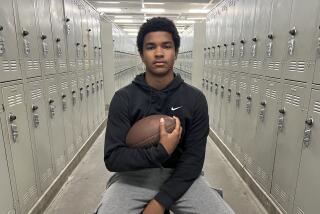A Numbers Game
- Share via
One scouting combine’s minimum acceptable height, weight and 40-yard times for NFL rookies this year, per position: OFFENSE
Position Ht. Wt. Spd. Center 6-1 1/2 259 5.3 Guard 6-1 255 5.2 Tackle 6-3 270 5.2 Wide Receiver 5-9 1/2 178 4.6 Tight End 6-2 223 4.8 Quarterback 6-1 195 5.0 Running back -- 193 4.7
DEFENSE
Position Ht. Wt. Spd. End 6-2 1/2 260 5.3 End* 6-1 1/2 269 5.4 Nose tackle 6-0 1/2 267 5.5 Tackle 6-1 1/2 271 5.4 Outside LB 6-1 222 4.7 Inside LB 6-0 1/2 225 4.8 Cornerback 5-9 179 4.6 Safety 5-10 189 4.7
*--3-man line.
Notes: Few acceptable candidates today weigh the minimum, or run it. . . . Speed times are rounded off to the nearest one-tenth of a second for 40 yards--although the scouts also compile 10- and 20-yard times, which are more informative for some positions. . . . Heights are rounded off to the nearest half inch. . . . Weight is always evaluated in tandem with speed. “The key is proper evaluation,” said former NFL Coach Sid Gillman, who added:. “It’s like the CIA. Every country can get all the intelligence stuff it needs, but almost no capital city evaluates it right.” . . . Faster football players are permitted to weigh less, so exact weight is meaningless without exact speed. . . . A running back’s “preferred” height is 5-10 to 5-11. For running backs, there’s no minimum, but there can be a maximum height: 6-2 1/2. . . . One combine lists minimum and maximum heights for incoming quarterbacks: 6-0 1/2 to 6-5 1/2. . . . Some figures change every year, sometimes more often than that.
The above chart is but a small extract from a combine book, in which, for example, average and minimum times and measures--among other things--are listed for candidates for positions in various systems. For example, there are different minimums for candidates for 49er-, Redskin- and Giant-type offenses and for the NFL’s two principal defensive systems. . . . The biggest weight variation is at guard, where the 49ers and Steelers, for instance, use smaller players than the Redskins and Chargers. . . . Tight ends also vary greatly in size. . . . At cornerback, the requirement isn’t so much height as jumping ability, which is easily measured but hard to improve.
Strength is normally measured in 225-pound bench-press repetitions. The strongest man at the Indianapolis combine convention in February was offensive guard David Postmus of Dayton, an Illinois transfer who managed 35 repetitions. He wasn’t drafted. . . . Indy combine officials are usually also the last word on 10-, 20-, and 40-yard times as well as the 60-yard shuttle for running backs. They also calculate height to eighths of an inch, standing- and vertical-broad jump distances and other figures that wind up, in time, on all draft charts. . . . The scouts’ principal objective is to discover each candidate’s basic quickness-speed factor. Speed is the most valued quality at all positions, regardless of size, hands, leaping or blocking ability or intelligence. . . . Except for Raghib Ismail, the fastest newcomer this year is Randal Hill of Miami, who was drafted by the cross-town Dolphins. Hill’s 40 time: 4.33. Or so they say.


